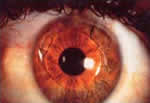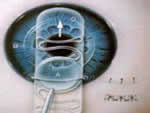Departments
Department of Refractive Surgery
What happens with high refractive abnormalities?
 In
higher ametropias, myopias over 10-11 degrees (diopters) and hyperopias over
4-5 degrees, the 15-year experience with laser showed that we achieve best
results with conventional operations or a combination of conventional operations
with laser. This is so because the thinning of the cornea is above the accepted
level in very high myopias and hyperopias and the eye’s safety is at
risk. Very high ametropias are best treated surgically with the insertion
of permanent intraocular lenses (lenses that are placed in the eye).
There are special intraocular contact lenses which are placed either behind
the iris (ICL) or in front of the iris (ARTISAN, PHAKIC 6).
In
higher ametropias, myopias over 10-11 degrees (diopters) and hyperopias over
4-5 degrees, the 15-year experience with laser showed that we achieve best
results with conventional operations or a combination of conventional operations
with laser. This is so because the thinning of the cornea is above the accepted
level in very high myopias and hyperopias and the eye’s safety is at
risk. Very high ametropias are best treated surgically with the insertion
of permanent intraocular lenses (lenses that are placed in the eye).
There are special intraocular contact lenses which are placed either behind
the iris (ICL) or in front of the iris (ARTISAN, PHAKIC 6).
 The
advantage of this method is that it is reversible. In other words, the lens
may be removed if necessary, something which is not possible with the laser
operation. For better and more anticipated results, these techniques are
combined with laser (bioptics), which is applied shortly after the intraocular
lens has been placed and a final ocular acuity is determined. We use the
laser to achieve the desired results, correcting the remaining ametropia
that is possibly left after the insertion of the lens.
The
advantage of this method is that it is reversible. In other words, the lens
may be removed if necessary, something which is not possible with the laser
operation. For better and more anticipated results, these techniques are
combined with laser (bioptics), which is applied shortly after the intraocular
lens has been placed and a final ocular acuity is determined. We use the
laser to achieve the desired results, correcting the remaining ametropia
that is possibly left after the insertion of the lens.
 If
the natural lens of the eye is hazy and the patient is quite aged and has high
myopia, an alternative
intervention is refractive lensectomy (clear lens extraction), that
is the removal of the eye's lens as in the case of the cataract and the insertion
of a corrective intraocular lens. The refractive lensectomy is best indicated
for aged people with high myopias who at the same time, are thus able to avoid
early on a possible removal of a cataract.
If
the natural lens of the eye is hazy and the patient is quite aged and has high
myopia, an alternative
intervention is refractive lensectomy (clear lens extraction), that
is the removal of the eye's lens as in the case of the cataract and the insertion
of a corrective intraocular lens. The refractive lensectomy is best indicated
for aged people with high myopias who at the same time, are thus able to avoid
early on a possible removal of a cataract.
In high astigmatism, astigmatic cheratotomies can be made, ie.
small incisions on the cornea facing each other, to change its uneven curvature.
In pathological situations as in keratoconus where we have very high astigmatism,
there is an indication for cornea transplant.
Copyright Hellenic Eyesurgery S.A. 2003-2008 - Terms
of Use - Website created & maintained by Theratron
 In
higher ametropias, myopias over 10-11 degrees (diopters) and hyperopias over
4-5 degrees, the 15-year experience with laser showed that we achieve best
results with conventional operations or a combination of conventional operations
with laser. This is so because the thinning of the cornea is above the accepted
level in very high myopias and hyperopias and the eye’s safety is at
risk. Very high ametropias are best treated surgically with the insertion
of permanent intraocular lenses (lenses that are placed in the eye).
There are special intraocular contact lenses which are placed either behind
the iris (ICL) or in front of the iris (ARTISAN, PHAKIC 6).
In
higher ametropias, myopias over 10-11 degrees (diopters) and hyperopias over
4-5 degrees, the 15-year experience with laser showed that we achieve best
results with conventional operations or a combination of conventional operations
with laser. This is so because the thinning of the cornea is above the accepted
level in very high myopias and hyperopias and the eye’s safety is at
risk. Very high ametropias are best treated surgically with the insertion
of permanent intraocular lenses (lenses that are placed in the eye).
There are special intraocular contact lenses which are placed either behind
the iris (ICL) or in front of the iris (ARTISAN, PHAKIC 6). The
advantage of this method is that it is reversible. In other words, the lens
may be removed if necessary, something which is not possible with the laser
operation. For better and more anticipated results, these techniques are
combined with laser (bioptics), which is applied shortly after the intraocular
lens has been placed and a final ocular acuity is determined. We use the
laser to achieve the desired results, correcting the remaining ametropia
that is possibly left after the insertion of the lens.
The
advantage of this method is that it is reversible. In other words, the lens
may be removed if necessary, something which is not possible with the laser
operation. For better and more anticipated results, these techniques are
combined with laser (bioptics), which is applied shortly after the intraocular
lens has been placed and a final ocular acuity is determined. We use the
laser to achieve the desired results, correcting the remaining ametropia
that is possibly left after the insertion of the lens. If
the natural lens of the eye is hazy and the patient is quite aged and has high
myopia, an alternative
intervention is refractive lensectomy (clear lens extraction), that
is the removal of the eye's lens as in the case of the cataract and the insertion
of a corrective intraocular lens. The refractive lensectomy is best indicated
for aged people with high myopias who at the same time, are thus able to avoid
early on a possible removal of a cataract.
If
the natural lens of the eye is hazy and the patient is quite aged and has high
myopia, an alternative
intervention is refractive lensectomy (clear lens extraction), that
is the removal of the eye's lens as in the case of the cataract and the insertion
of a corrective intraocular lens. The refractive lensectomy is best indicated
for aged people with high myopias who at the same time, are thus able to avoid
early on a possible removal of a cataract.